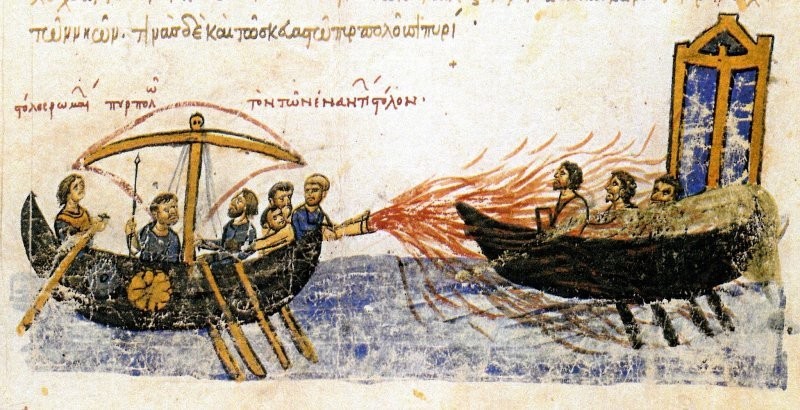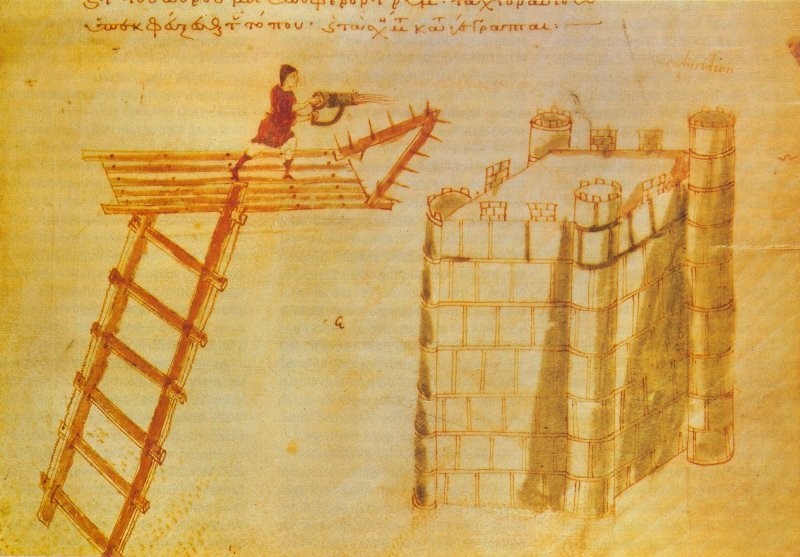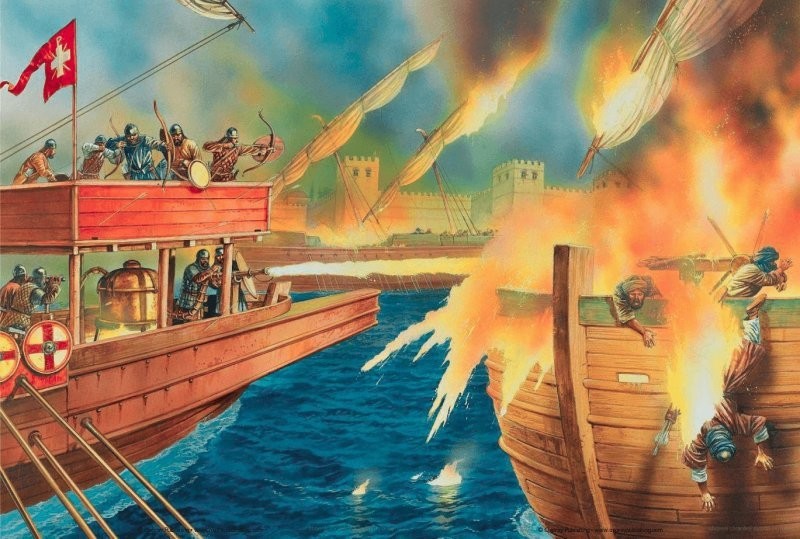A Byzantine superweapon that incited fear in the hearts of enemies. History of Greek fire (7 photos)
In 717, the Arab troops besieging Constantinople found themselves in a difficult situation. The Byzantine emperor, asking for help from the Bulgarian Khan Travel, forced the attackers to become defenders: they had to protect their rear from the attacks of the Bulgarians. And in front of them still stood the walls of the Byzantine capital, which had withstood more than one siege and remained just as impregnable. 
Using Greek fire. Miniature of the Madrid Skylitzes, "Chronicles" of John Skylitzes
The most vulnerable point of the city was the Bosporus, and the Arabs, having significant naval forces, could have quickly won by landing from ships beyond the line of the city walls, but they were in no hurry to act in this way. After all, there was one circumstance that caused them serious concerns.
Taking advantage of the delay of the Mohammedans, the Byzantine Emperor Leo III collected all the ships he had, equipped them with secret weapons and led them into battle. In one day, the besieging fleet was defeated and most of it was destroyed. The Arabs lost a significant amount of supplies and transport, and widespread hunger and disease began in the camp. This was the reason for their retreat, and the secret weapon that ensured victory for the Byzantines turned out to be the legendary Greek fire, widely known for hundreds of years.
Fire has been used in warfare since ancient times. Despite the fact that fire arrows began to be used simultaneously with the advent of the bow, their effectiveness was low due to their low incendiary ability. Fire arrows and arson are mentioned in the most ancient sources, but at sea the use of fire was limited for quite a long time. It would seem that wood, the main material of ships of that time, burns well, but a large amount of water around neutralizes the effectiveness of using flame in battle. In addition, delivering it to the enemy is extremely problematic.
The use of devices that spew fire at the enemy is often found in references to the era of the ancient world. For example, there is similar information in the history of the attack on the island of Rhodes in 190 BC, as well as about the land battle of Delia in 424 BC. The description of the latter speaks of a certain mechanism in the form of a “hollow log” from which an incendiary mixture “of sulfur, crude oil and oil” was released. 
The use of a hand-held cheirosiphōn during the siege of a fortress. A hand-held device for throwing Greek fire. Miniature of the Poliorcetics manuscript
Strengthening the army and improving technology allowed the Byzantine Empire to gain superiority over its enemies at the beginning of the Middle Ages. It is believed that Greek fire was invented by a certain Callinicus, an engineer from Heliopolis conquered by the Arabs. In addition, a device was created that threw it over a distance that was significant by the standards of that time. The siphon (or siphonophore), as described by contemporaries, with “thunderous noise and smoke” spewed streams of liquid fire at the enemy. The range of the siphons was approximately 30 meters, however, due to the bulkiness of the design, as well as the need to constantly have a supply of the mixture, it was used mainly in the navy.
For the slow-moving ships of that time, such weapons were a terrible threat. The fire spewed out by the siphons could not be extinguished with water and knocked down by the wind. One or two salvos from a siphon or a hit from a barrel with this composition was enough to destroy a large ship. And even if he missed, the flaming mixture that spread across the water could set other ships on fire.
Against most opponents it was a real superweapon. His fame was so great that most enemies preferred to stay away from any Byzantine ships. 
Siphon (or siphonophore) as represented by modern artists
The recipe for making Greek fire was a secret that was carefully guarded. Based on some data, it can be assumed that its composition included crude oil, quicklime, asphalt and calcium phosphide. Restoring the composition is complicated by the fact that when translating some historical documents it is difficult to understand what exactly the author meant. So, for example, the word “sulfur” could at different times and with different translations mean both sulfur and animal fat.
However, the description of the effect produced by Greek fire is the same in all translations. The main one is combustion on water, and sometimes there are descriptions that say that it “lights up with water.” Greek fire was a liquid and thick substance, and it could only be extinguished to a certain extent.by these means. There is also almost universal reference to the "loud boom and a lot of smoke" from using the ancient superweapon in battle. 
A Byzantine siege engine throws a barrel of Greek fire into a fortress, 13th century. Engraving from Harper's Magazine, 1869
The formula of Byzantine know-how was lost with the fall of the empire and the capture of Constantinople by the Turks. By this time, they had already found some ways to counter the fire weapons of the Greeks. It was useless to pour water on the Greek fire, but covering it with sand, or, as Arab sources claim, pouring it with “old urine” worked perfectly. Raw sheepskins were also used to cover the decks of ships, which also provided some protection.
The massive spread of gunpowder and weapons based on it gradually negated all the advantages of Greek fire. The last historical mention of it dates back to 1453, when the Battle of Constantinople took place. It is believed that after this battle this technology was lost, however, according to some assumptions, this happened even earlier: after Byzantium lost access to some of the components of the composition that were mined in the abandoned provinces.
One way or another, at the moment we can only speculate on its original composition. The problem for restoring the formula was also that the Byzantines, for security reasons, never trusted the recipe for the entire chain of production and use of their secret weapon to one person. There is a known case when, during the capture of Mesemvria and Deltos in 814, at least 36 serviceable siphons for throwing fire and a certain amount of the mixture itself fell into the hands of the invaders. However, they were never able to use them. 
Hand grenades filled with Greek fire. And “garlic” used against cavalry. Photo from the National History Museum in Athens
Throughout modern times, attempts were made repeatedly in Europe to restore the production of Greek fire. And despite the loss of its status as a superweapon, it was believed that it could still provide a significant advantage to those who received it at their disposal. There is a known case when in 1758 a French scientist announced that he had recreated the recipe. At a demonstration before King Louis XV, he managed to burn a ship in the roadstead. The king was impressed by the results and bought all the papers related to his work from the inventor. However, instead of using them, he destroyed the records. 
The use of Greek fire as represented by contemporary artists
With the improvement of weapons and military craft, Greek fire, of course, no longer made such a threatening impression as in the period of Antiquity and the Middle Ages. Armies began to arm themselves with much more powerful and effective types of weapons. However, in history, Greek fire will forever remain a mysterious composition that burns entire fleets.






























